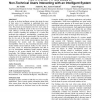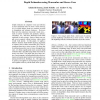1019 search results - page 134 / 204 » Managing Complexity in Large Learning Robotic Systems |
CHI
2007
ACM
14 years 8 months ago
2007
ACM
In order to develop intelligent systems that attain the trust of their users, it is important to understand how users perceive such systems and develop those perceptions over time...
ESANN
2006
13 years 9 months ago
2006
Abstract. Response surfaces are a powerful tool for both classification and regression as they are able to model many different phenomena and construct complex boundaries between c...
KBSE
2008
IEEE
14 years 2 months ago
2008
IEEE
For large software systems, interface structure has an important impact on their maintainability and build performance. For example, for complex systems written in C, recompilatio...
IM
2003
13 years 9 months ago
2003
: Monitoring is a fundamental building block of any network management system. It is needed to ensure that the network operates within the required parameters, and to account for u...
IJCAI
2007
13 years 9 months ago
2007
Depth estimation in computer vision and robotics is most commonly done via stereo vision (stereopsis), in which images from two cameras are used to triangulate and estimate distan...


